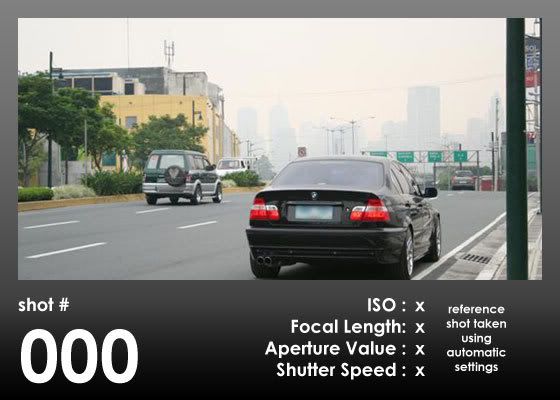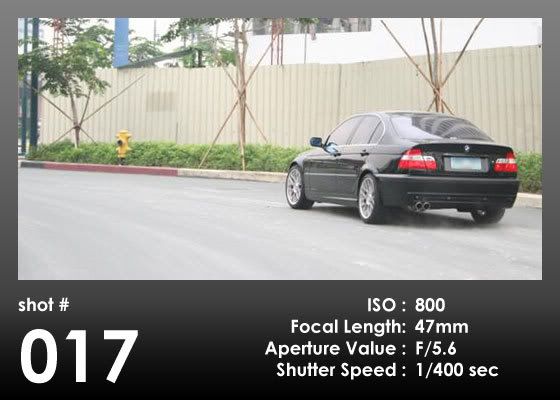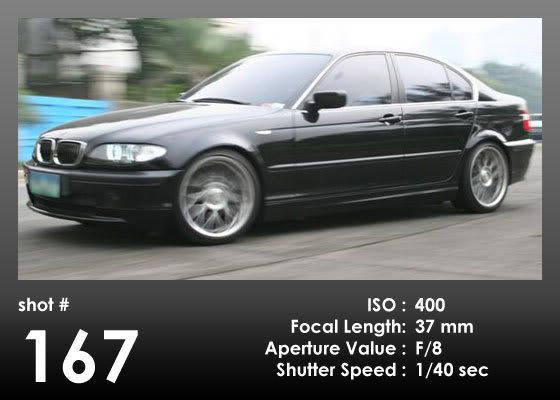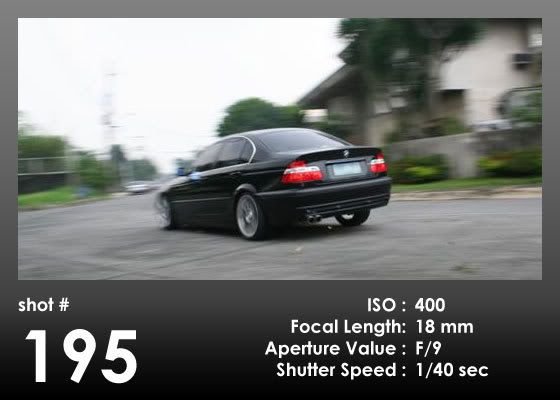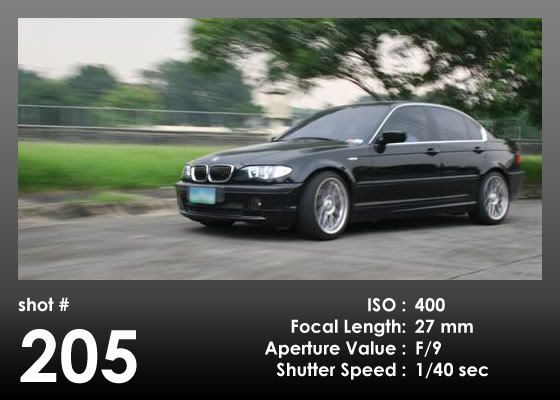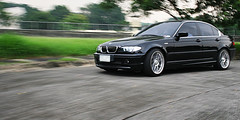:: Tune Up ::
00:12 | view comments
On Jayvee's recommendation, I've decided to give a tutorial of sorts on shooting cars, or other fast-moving objects for that matter. In the state I'm in though, I'll probably end up writing a journal - something like a narrative of what transpired during our shoot.
In any case, If you've seen this photo from my previous post and you're wondering how I did it, then read on. If you don't particularly care, then I suggest you jump off to another page. With that disclaimer of sorts out of the way, let's get down to business.
Before I give the details of the shoot, however, here is, quoted from my previous post, the reason for this shoot: "Thinking that he was selling his car in a few days, my friend decided he wanted some photos to remember his ride by. With this in mind, he and I decided to go on a photo shoot."
Now, on to the nitty-gritty. Because I haven't quite acquired the knack for knowing what settings to just by looking around - at least not yet - I fired off some test shots using one of the automatic settings. Mind you, I was shooting from another car, and we were both speeding down the road. Looking back, I'm glad I didn't lose my grip on my camera.
In this shot, the sky is overcast, gray, and otherwise dull. The day wasn't exactly ideal for shooting outdoors, but we decided to try anyway. I switched to manual, checked the settings on the reference shot, and got ready to shoot.
Because I was shooting a moving car and I couldn't exactly repeat any action I hadn't captured, I switched to continuous shooting mode. Since I was shooting from another car, I decided to take another precaution - I raised my shutter speed.
In my first round of shots, the car exposed almost perfectly - but there was something very wrong. It was only (very) slightly overexposed, and that could have easily been corrected in post-processing. In fact, the car looked pretty good. The problem was it didn't look fast.
If not for the faint dust cloud behind the wheels and the slight roll to the right, it looks like the car in this image is standing still. If you look closely at the wheels, in fact, it looks like they're not spinning at all.
After the first round of shots, we had to ditch the chase car. We also had to retreat to another location. We also had to pray to the powers-that-be to keep the rain away.
One car less and a location change later, we were shooting again. I wanted the get the sense of motion we had lost earlier, so I reduced my shutter speed by several stops. This produced the image of an overexposed car moving slowly.
By this time I had realized that my settings were completely off. Colors were dull, highlights were blown, and everything was pretty much overexposed. On top of that, the car looked slow. If I wanted to get the shot right before the light changed on me, I would have to adjust different variable all at once.
First off, I had to make the car look faster. I slowed the shutter down to 1/40 of a second, and took a shot while panning at roughly the speed I had been moving in the previous shots. I was happy with the background blur in the test shot; and I was hoping the wheels would get a nice blur on them too.
Next on the agenda was compensating for the slower shutter speed. I dropped the ISO to 400 and stepped the aperture down to F/8. We then did a test run and came up with this shot. It looked pretty good - but it wasn't quite there yet. The sky, not to mention the roof, was still blown out.
An F-Stop and a batch of pictures later, we came up with the following image. Pretty good, but still not quite there. The car was pretty much dialed in, but the background was still troubling me.
At this point I decided that we couldn't make any more adjustments to get the sky looking right - we would have to find a way to hide it. I didn't want a house dominating the background - it just didn't feel right. I wanted an industrial or a least a commerical look, but I didn't want to switch to yet another location. Thankfully, there was a tree and an empty lot right behind me. Greenery would just have to do.
Shooting from a reverse angle, I snapped away just as the car was running past the tree. This helped the exposure several ways. First, it put the car in the shade - preventing the roof and parts of the hood from blowing out. Second, the tree blocked most of the sky in the background - adding more texture (and blur) to the shot. Third, the change of angle revealed a piece of sky that was filled with gray clouds - giving me a sky that wasn't completely blown out.
All this resulted in a the shot you see here. After getting this, we ran back and forth a few more times and took roughly another hundred photos. We found a handful of good shots, but none quite like #205.
Finally, after a bit of post-processing, we have the image you see here. I can still think of a bunch of ways to improve the image, but they don't exactly fall under the realm of basic image processing. At some point, I might try transplanting the car into a picture on an actual racetrack. Before that, I could simply play with the sky and turn it blue. More likely than either of these possibilities though, I think I'll just get behind the camera again and try to get an even better shot.
Until then, this image will just have to do.
00:12 | view comments
On Jayvee's recommendation, I've decided to give a tutorial of sorts on shooting cars, or other fast-moving objects for that matter. In the state I'm in though, I'll probably end up writing a journal - something like a narrative of what transpired during our shoot.
In any case, If you've seen this photo from my previous post and you're wondering how I did it, then read on. If you don't particularly care, then I suggest you jump off to another page. With that disclaimer of sorts out of the way, let's get down to business.
Before I give the details of the shoot, however, here is, quoted from my previous post, the reason for this shoot: "Thinking that he was selling his car in a few days, my friend decided he wanted some photos to remember his ride by. With this in mind, he and I decided to go on a photo shoot."
Now, on to the nitty-gritty. Because I haven't quite acquired the knack for knowing what settings to just by looking around - at least not yet - I fired off some test shots using one of the automatic settings. Mind you, I was shooting from another car, and we were both speeding down the road. Looking back, I'm glad I didn't lose my grip on my camera.
In this shot, the sky is overcast, gray, and otherwise dull. The day wasn't exactly ideal for shooting outdoors, but we decided to try anyway. I switched to manual, checked the settings on the reference shot, and got ready to shoot.
Because I was shooting a moving car and I couldn't exactly repeat any action I hadn't captured, I switched to continuous shooting mode. Since I was shooting from another car, I decided to take another precaution - I raised my shutter speed.
In my first round of shots, the car exposed almost perfectly - but there was something very wrong. It was only (very) slightly overexposed, and that could have easily been corrected in post-processing. In fact, the car looked pretty good. The problem was it didn't look fast.
If not for the faint dust cloud behind the wheels and the slight roll to the right, it looks like the car in this image is standing still. If you look closely at the wheels, in fact, it looks like they're not spinning at all.
After the first round of shots, we had to ditch the chase car. We also had to retreat to another location. We also had to pray to the powers-that-be to keep the rain away.
One car less and a location change later, we were shooting again. I wanted the get the sense of motion we had lost earlier, so I reduced my shutter speed by several stops. This produced the image of an overexposed car moving slowly.
By this time I had realized that my settings were completely off. Colors were dull, highlights were blown, and everything was pretty much overexposed. On top of that, the car looked slow. If I wanted to get the shot right before the light changed on me, I would have to adjust different variable all at once.
First off, I had to make the car look faster. I slowed the shutter down to 1/40 of a second, and took a shot while panning at roughly the speed I had been moving in the previous shots. I was happy with the background blur in the test shot; and I was hoping the wheels would get a nice blur on them too.
Next on the agenda was compensating for the slower shutter speed. I dropped the ISO to 400 and stepped the aperture down to F/8. We then did a test run and came up with this shot. It looked pretty good - but it wasn't quite there yet. The sky, not to mention the roof, was still blown out.
An F-Stop and a batch of pictures later, we came up with the following image. Pretty good, but still not quite there. The car was pretty much dialed in, but the background was still troubling me.
At this point I decided that we couldn't make any more adjustments to get the sky looking right - we would have to find a way to hide it. I didn't want a house dominating the background - it just didn't feel right. I wanted an industrial or a least a commerical look, but I didn't want to switch to yet another location. Thankfully, there was a tree and an empty lot right behind me. Greenery would just have to do.
Shooting from a reverse angle, I snapped away just as the car was running past the tree. This helped the exposure several ways. First, it put the car in the shade - preventing the roof and parts of the hood from blowing out. Second, the tree blocked most of the sky in the background - adding more texture (and blur) to the shot. Third, the change of angle revealed a piece of sky that was filled with gray clouds - giving me a sky that wasn't completely blown out.
All this resulted in a the shot you see here. After getting this, we ran back and forth a few more times and took roughly another hundred photos. We found a handful of good shots, but none quite like #205.
Finally, after a bit of post-processing, we have the image you see here. I can still think of a bunch of ways to improve the image, but they don't exactly fall under the realm of basic image processing. At some point, I might try transplanting the car into a picture on an actual racetrack. Before that, I could simply play with the sky and turn it blue. More likely than either of these possibilities though, I think I'll just get behind the camera again and try to get an even better shot.
Until then, this image will just have to do.


